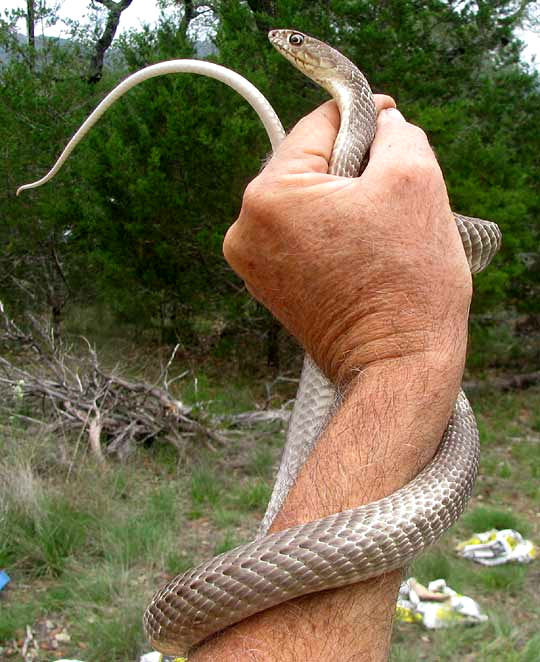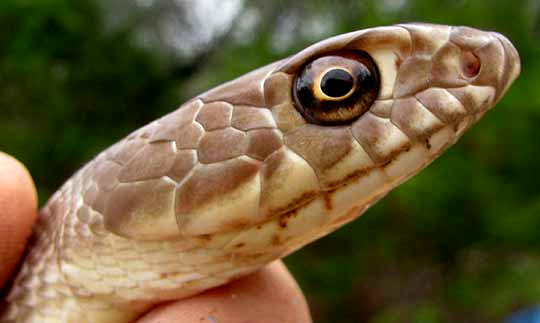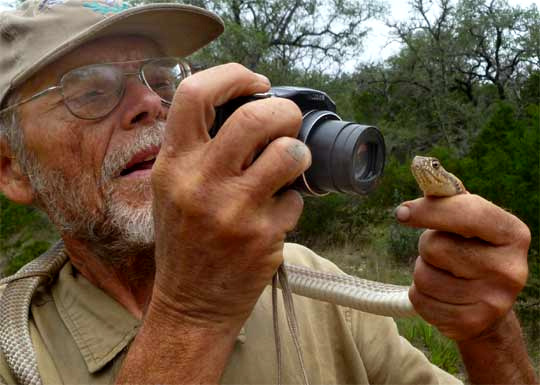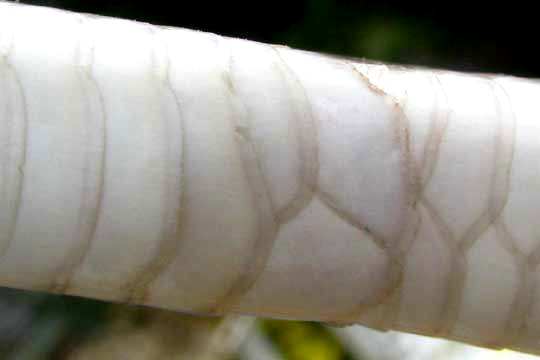Excerpts from Jim Conrad's
Naturalist Newsletter
from the June 2, 2013 Newsletter issued from the Frio Canyon Nature Education Center in northern Uvalde County, southwestern Texas, on the southern border of the Edwards Plateau; elevation ~1750m (~5750 ft); N29.62°, W99.86°; USA
COACHWHIP SNAKE
On the hill where we're building a nature education center I was pulling out an 80 pound bag of cement when I noticed the shiny scales of a pale brown or tan snake maybe a yard long (1m) making himself at home among remaining stacked bags. Below you can see him once he was pulled out:

You can tell from the loose way he's being held that he behaved very tamely and didn't try at all to bite. Though he was clearly not a venomous species I wasn't sure what he was, so I took pictures to help with the identification later. Most important with most unidentified new snakes is the configuration of scales on the head, so you can see them below:

In that picture, note the pronounced crest over the eye. My friend Phred, who was pouring cement with me, photographed me taking the above picture, so you can see how that looked below:

It's always a good idea to note whether an unknown snake's "anal plate" -- the plate or scale on the belly just in front of and covering the cloacal opening (where poop comes out) -- is single or divided. Belwo you can see that this snake's anal plate is divided :

In that picture the snake's front is to the left, the tail to the right. You can see that single belly scales stretch across the forward part of the snake's belly, but on the tail end the bottom is covered by two rows of scales. A little to the right of the picture's center where the row of single belly scales meet the double row of scales there's an especially large scale with a diagonal break across its middle. That's the divided anal plate. Anal plates are important when identifying groups of snakes. For instance, garter snakes, king snakes, and pit vipers possess single anal plates -- so our snake definitely isn't one of those -- but water snakes, racers, and rat snakes have divided ones.
Also it's important to notice whether a snake's body scales are "keeled" or not -- whether there's a thin ridge running down the back of each scale. The scales of water snakes, rattlers, garter snakes and hognose snakes are very conspicuously keeled, while rat snake scales are weakly keeled, and kingsnakes and racers have smooth ones with no keels. You can see that our snake's scales are not keeled at all below:

My first impression was that this was a Racer, a species I know very well from back East. Most Racers there are black, but I knew there was a paler subspecies possibly found in our area. However, a local fellow, upon seeing the pictures Phred sent him, said it was a Coachwhip. Coachwhips I've seen elsewhere had blackish front ends, but in our area there's a subspecies colored just like the one in our picture.
In fact, the pale subspecies of the Racer and Coachwhip are so similar that really I couldn't tell them apart until on the Internet I found diagrams showing the configuration of head scales of each species. Those diagrams, provided by the Florida Museum of Natural History... {UPDATE: ...no longer are available, but on the Internet you can look for pictures enabling you to compare head scales on Racers and Coachwhips}
Those diagrams {were} almost identical, except for scales along the top of the mouth between the eye and tip of the nose. Starting with the large scale above the lip and with a much smaller scale at its top, left touching the eye, and counting toward the tip of the nose, the Coachwhip has three scales. However, in the same spot, the Racer has only two. Our snake has three scales, so it's a Coachwhip, MASTICOPHIS FLAGELLUM.
More exactly, it's the pale Western subspecies of the Coachwhip, Masticophis flagellum ssp. testaceus, occurring from southwestern Nebraska and western Colorado south through eastern New Mexico and west and central Texas into Mexico. The broader Coachwhip species occurs across the entire southern one-third of the US, coast to coast, and deep into Mexico.
Without finding those scale diagrams I don't think I'd ever have been able to distinguish the two species. But that one extra upper-lip scale between the eye and the nose made it all easy, once the secret was known.